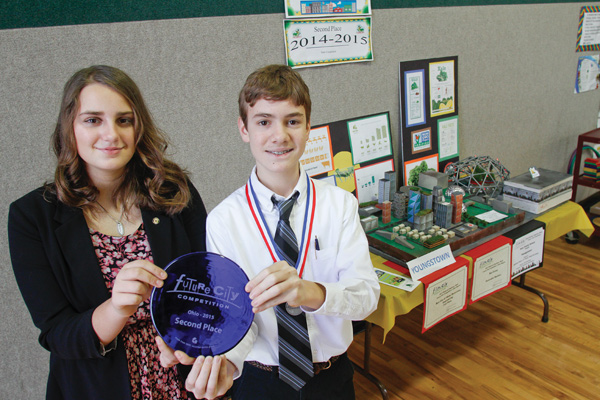Holy Family students win for vision of future Youngstown


Paige Brockway and Matthew Rossi, eighth-grade students at Holy Family School in Poland, hold the second-place trophy from the Future City Competition. Brockway and Rossi, along with a group of more than 20 other sixth-, seventh-, and eighth-grade Holy Family students, chose Youngstown as the city they would design in its future form. The competition asks participants to design a city, research a solution to a social problem and then build a model of the city using recycled materials. This was Holy Family’s best year in the state competition.
POLAND
The year is 2172.
Youngstown has evolved into a thriving, productive city, with many of the same landmarks we see around town today, as well as many new ones.
The city has become self-sustaining with two locally produced food sources: crickets and kale.
Robotic nurses, advanced GPS devices, hydroelectric energy from wastewater plants and a high-speed highway powered by wind energy are just a few other characteristics of this low-crime, education-oriented city.
This version of the city’s future, as envisioned by a group of about 25 sixth-, seventh-, and eighth-grade Holy Family School students, won honors at the state Future City Competition earlier this month.
The national competition — this year featuring the theme “Feeding Future Cities” — asks students to design and build models of cities of the future to introduce them to the basics of engineering. Students design virtual cities using SimCity software, research and write an engineering solution to a social need, build scale models of their city using recycled materials, write a narrative and then present their ideas before judges.
Holy Family’s second-place win this year in a pool of 19 Ohio schools was the furthest the school has ever gone in its 14 years in the competition — and, it was the first time students chose their hometown as the city they would model.
The Holy Family students’ project focused on what they see as a bright future for their hometown.
“Today, in 2172, Youngs-town is revived; construction and maintenance of a bold local food economy has created jobs and drawn people back to this remarkable city. Now home to 365,100 citizens, Youngstown is again a great place to call home! ... Our nation was built on the steel Youngstown manufactured, but today, the nation is held together with the food Youngstown grows,” they said in their research paper.
Tasked with the challenge of selecting one vegetable and one protein that could grow in a city and feed the population, Holy Family students met with two local food producers: The Lettuce People, a company that grows hydroponic lettuce, and Big Cricket Farms.
“We wanted to find a way to grow [those things], and when we found it, we said we could just do it in Youngstown,” said Matthew Rossi, who, along with Paige Brockway and J.P. Yerian, all eighth-graders, gave the presentation in Columbus.
The students also planned out every facet of the city’s services, from parks and recreation to water treatment to education. The model incorporated both existing aspects of Youngstown, and some new ones.
“We used a lot of buildings that already exist,” Rossi said. Youngstown State University, the Covelli Centre, the Public Library of Youngstown and Mahoning County and others are included. New to the city are domes where the kale and crickets would be grown.
“The reason the team chose Youngstown is because the city has had a history of prosperity and of depression with the steel mills closing,” said Charlotte Eskay, the teacher who led the project. “We’re experiencing growth now, and the future looks so hopeful. We wanted to project that into the future.”
 43
43
